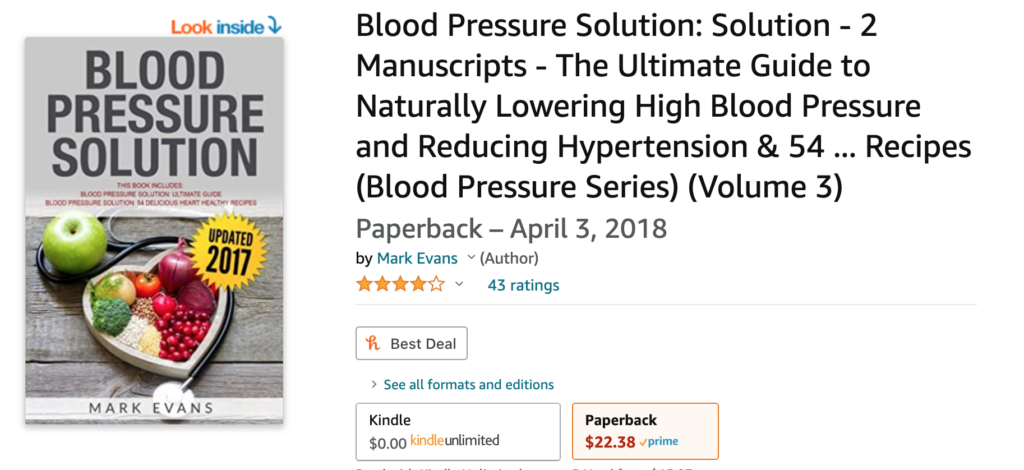HIGH BLOOD PRESSURE OVERVIEW
Hypertension (high blood pressure) is a common condition that can lead to serious complications if untreated. These complications can include stroke, heart failure, heart attack, and kidney damage. Worldwide, hypertension contributes to cardiovascular death more than any other risk factor. Making dietary changes (reducing sodium intake and increasing potassium intake) and losing weight are effective treatments for reducing blood pressure [1,2]. Other lifestyle changes that can help include stopping smoking, reducing stress, reducing alcohol consumption, and exercising regularly. All forms of physical activity are beneficial and should include least 150 minutes per week of moderate activity or 75 minutes per week of strenuous activity. All of these lifestyle changes are effective when used alone but often have the greatest benefit when used together. Many patients with hypertension will also require medications to lower their blood pressure to safe levels.
DIETARY CHANGES AND BLOOD PRESSURE
Making changes to what you eat can help to control high blood pressure [1].
Reduce sodium (salt) — Reducing the amount of sodium you consume can lower blood pressure if you have high or borderline-high blood pressure.
The main source of sodium in the diet is the salt contained in packaged and processed foods and in foods from restaurants.
The body requires a small amount of sodium in the diet, and most people consume more sodium than they need (over 3 grams per day). A low-sodium diet contains fewer than 2.4 grams (2400 milligrams) of sodium per day. Although the ideal target for daily sodium intake remains controversial, the optimal goal is less than 1500 mg per day. For most adults with hypertension, however, a 1000 mg per day reduction in serum sodium intake (compared with current intake) can help reduce your blood pressure.
A detailed discussion of low-sodium diets is available separately.
Reduce alcohol — Drinking an excessive amount of alcohol increases your risk of developing high blood pressure. A “drink” is defined as 5 oz of wine, 12 oz of beer, or 1 oz of hard liquor. People who consume more than two drinks per day have an increased risk of high blood pressure compared with nondrinkers, and binge drinking (consuming four to five drinks within two hours) is an even greater problem for overall health and hypertension.
On the other hand, drinking one (for women) or two (for men) drinks per day appears to benefit the heart in people greater than 40 years old. This protective effect also applies to people with preexisting high blood pressure.
Eat more fruits and vegetables — Adding more fruits and vegetables to your diet may reduce high blood pressure or protect against developing high blood pressure. A strict vegetarian diet may not be necessary.
Eat more fiber — Eating an increased amount of fiber may decrease blood pressure. The recommended amount of dietary fiber is 20 to 35 grams of fiber per day. Many breakfast cereals are excellent sources of dietary fiber. More information about increasing fiber is available separately.
Eat more fish — Eating more fish may help to lower blood pressure, especially when combined with weight loss.
Caffeine — Caffeine may cause a small rise in blood pressure, although this effect is usually temporary. Drinking a moderate amount of caffeine (less than 2 cups of coffee per day) does not increase the risk of high blood pressure in most people.
Dietary Approaches to Stop Hypertension (DASH) eating plan — The DASH eating plan combines many of the interventions noted above. It is high in fruits and vegetables, low-fat dairy, and fiber. Patients who strictly follow the DASH eating plan can also have fairly significant reductions in blood pressure, particularly when combined with a low-sodium diet.

EXERCISE
Regular exercise such as walking or running (75 minutes per week of strenuous activity or 150 minutes per week of moderate activity) can lower your blood pressure, even if you don’t lose weight. To maintain this benefit, you must continue to exercise; stopping exercise will allow your blood pressure to become high again.
WEIGHT LOSS AND BLOOD PRESSURE
Being overweight or obese increases your risk of having high blood pressure, diabetes, and cardiovascular disease. The definition of overweight and obese are based upon a calculation called body mass index (BMI). A person is considered overweight if their BMI is greater than 25, while a person with a BMI of 30 or greater is classified as obese. People who are overweight or obese can see significant reductions in blood pressure with even modest weight loss.
To lose weight, you must eat fewer calories and exercise more.
AVOID TAKING MEDICATIONS AND SUPPLEMENTS THAT INCREASE BLOOD PRESSURE
In susceptible individuals, nonsteroidal antiinflammatory drugs, otherwise known as NSAIDs (ibuprofen, naproxen, etc), can increase blood pressure. Oral contraceptive pills may increase blood pressure in some women. Additionally, any stimulant, including those found in some decongestants, weight loss products, and illicit drugs, can increase blood pressure. If you are regularly consuming any of these substances, you should talk to your health care provider.
WHAT IF I STILL HAVE HIGH BLOOD PRESSURE?
If you continue to have high blood pressure despite making lifestyle modifications including changes in your diet, exercising more, and losing weight, you may need a medication to reduce your blood pressure.
